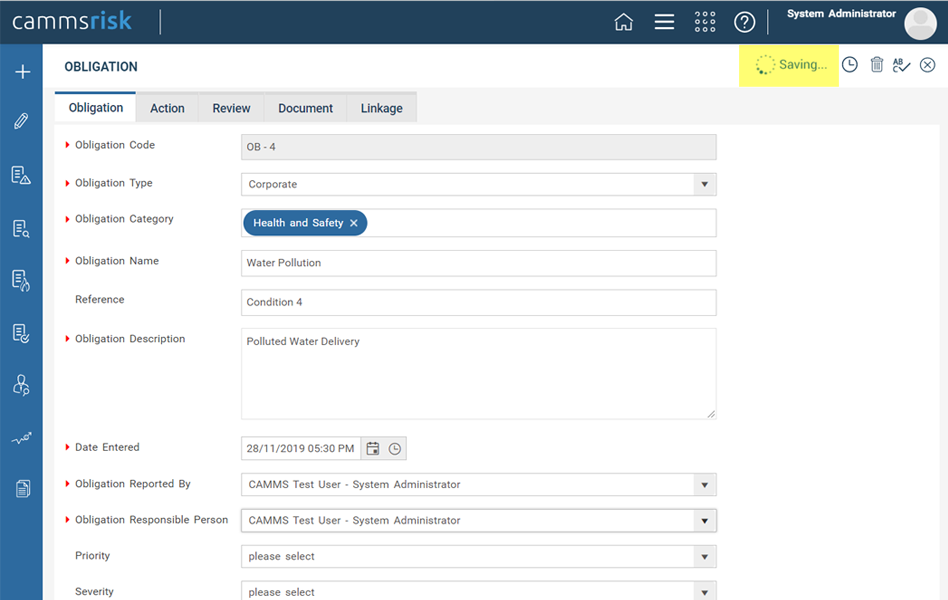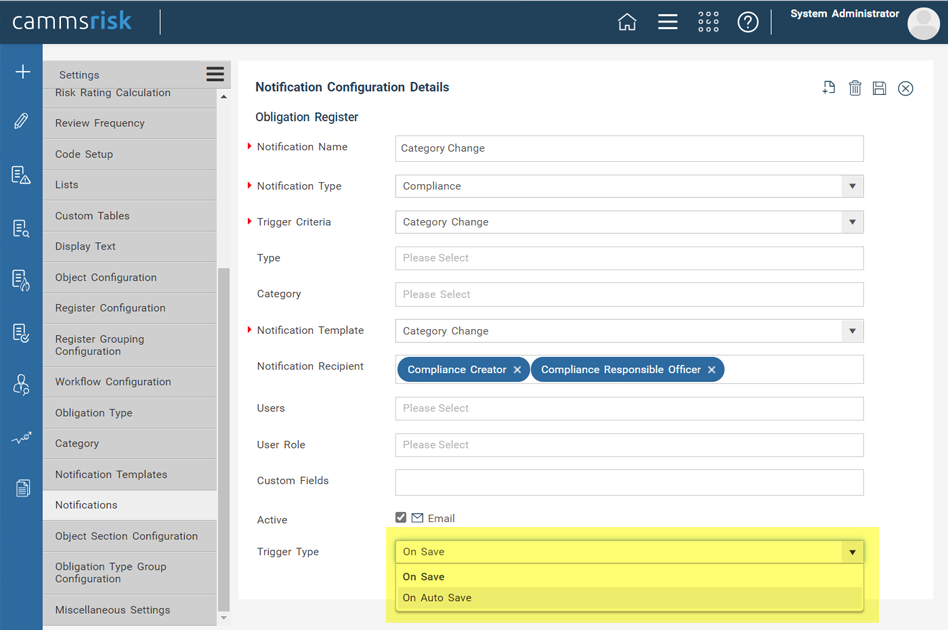
Camms is pleased to announce the September Feature Release for Camms.Risk Compliance Management.
This was released on 19th September and includes the following new features and enhancements to improve your user experience within the system.
1. Introducing auto-save for your data
An auto-save feature has been introduced, where compliance data will be saved in a pre-defined frequency to prevent data loss due to interruptions. This prevents the end-user from the need to manually save information in the expectation of an event of an application crash or due to human errors such as accidently closing the browser window.
How to do the configurations ?
- A new setting as ‘Auto-Save Frequency'’ has been introduced within ‘Miscellaneous Settings’ (accessed via Camms.Compliance > Mega Menu > Complaince Settings > Miscellaneous Settings)
- To activate the auto-save feature a numeric value needs to be inserted within the numeric box which will determine the frequency in minutes
- The minimum auto-save frequency is 5 minutes. Keeping it blank would turn off the auto-save feature
- Decimals, alphabets and characters cannot be entered

Image 1 : Auto-Save Frequency setting
How will it work?
- The auto-save will run in the background for the object the user is currently in and will display a message as ‘Saving..’ when it happens. The user can continue to work on the application without any disruption to the ongoing work. The data will be saved up to the point the auto-save happened.

Image 2 : Auto-save message
- The mandatory validations will not be validated at the time of auto-save
- The user will not be able to do a manual save at the time the auto save is happening but could do so at any other given time
- At the time of a compliance record creation, if the auto -ave happens the compliance data will not get saved. The user will need to manually save the data in order for the compliance record to get created and be visible in the register
Note: The same is applicable for compliance actions as well.
- The auto-save will run and save information only if the user has done any changes to the record between the frequency cycles
- The auto saved information will be updated in compliance history.
Where will it not work?
- The feature will not work in the below mentioned objects
- Linkage Object
- Document Object
- My Quick Update
- Incident Portal
Will emails get triggered on Auto-Save?
- A new dropdown named as ‘Trigger Type’ has been introduced in the Notification configuration screen for most Notification types and its trigger criteria.
- This will include the options of ‘On Save’ and ‘On Auto-Save’ as the trigger types.

Image 3 - Email trigger type
- The ‘On Save’ option will be the default and will trigger emails only on the manual save of compliance details. The ‘On Auto Save’ option will trigger emails when changes are saved on Auto-Save
- The ‘On Auto-Save’ option is not applicable for the following triggers
- Compliance - New compliance created
- Entity Alert - Alert Submitted
- Increased security conditions for bulk emails
The security of consolidated emails have been improved to ensure that the content within the email is filtered out based on the permission of the recipient.
How to do the configurations?
- The recipient’s user permission will consider the permission to view compliance records in the register configured in the standard permissions within a user role (accessed via Camms.Compliance > Framework > Compliance Settings > User roles)
Note: If the user has flexible hierarchy then it should also consider the Register ‘View’ permissions (Accessed via Camms.Compliance > Administrations > Role Management)
- This security improvement has been applied to the notification recipients entered in the following fields in the ‘Notification Configuration Details Page’
- Notification Recipient
- Users
- User Roles
How will this work?
- The security permission is applied to notifications where the ‘Send Consolidated emails’ tick box is selected.
- Users will receive a consolidated email for the following email triggers for the notification type ‘Compliance’
- Compliance Created
- Compliance Assigned to a user
- The email template must include the snippet ‘Compliance Requirement List’. The email triggered to the recipient will filter and display only the compliance records in the list that the recipient has permission to view.
For example: User A has been assigned 3 compliance records and is the compliance responsibility officer and User B has been assigned 2 compliance records and is the compliance responsibility officer. The recipients are Compliance Responsible Officer and User C. User C has ‘View all records in register’ permissions. A single consolidated email will be triggered based on the set frequency. The consolidated email will filter and show User A only the records assigned to him and will not display the records of User B. User C will records of both User A and User B.
- Users will receive a consolidated email for the following email triggers for the notification type ‘Actions’
- Action Due Date
- Action Status Change
- According to Action Status
- The email template must include the snippet ‘Compliance Action List’. The email triggered to the recipient will filter and display only the compliance action records in the list that the recipient has permission to view
- Users will receive a consolidated email for the following email triggers for the notification type ‘Review’
- According to Compliance Review Frequency’
- The email template must include the snippet ‘Compliance Review List’. The email triggered to the recipient will filter and display only the compliance review records in the list that the recipient has permission to view
2. Improvements to the Document and Linkage objects
Document Object
- Document uploads within the Document Object have been improved to provide ease of use to the end user. When uploading a document it will now automatically upload the document and save it without having the need to manually save
- However on ‘Edit’, document details such as document title and document description will not be automatically saved if a document is not uploaded, and therefore will require to be manually saved
Linkage Object
- Adding linkages within the Linkage Object will automatically get saved upon selection of the linkage
- This improvement is applied for all Linkage types except the ‘Hierarchy’ linkage type. If the user selects the linkage type as ‘Hierarchy’, the selected hierarchy nodes will require to be manually saved
